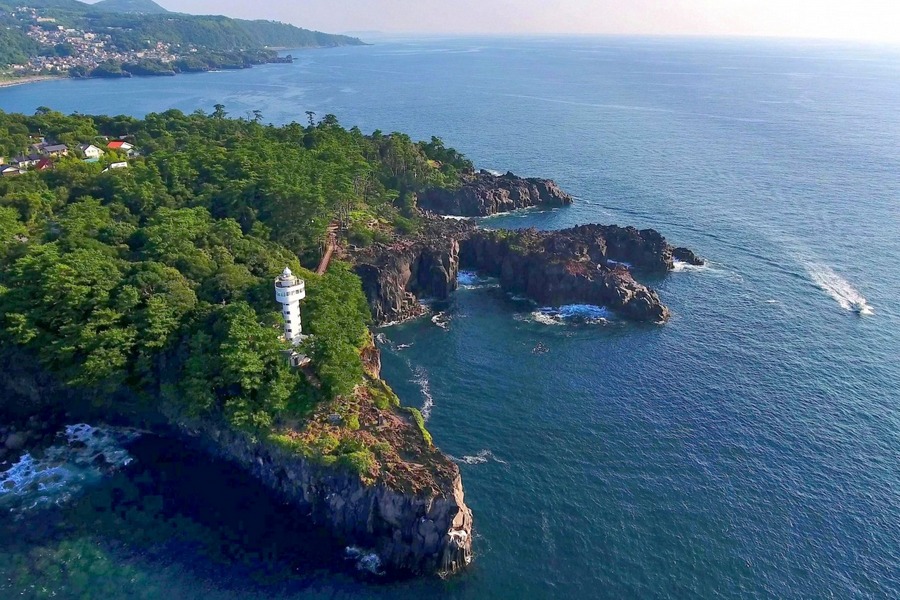Japan’s Izu Peninsula is a small place with incredible diversity. Roughly 35km wide by 55 km long, the scenery, history and lifestyles change dramatically as you cross one of its many mountain passes. One example of this is the stark contrast between Ito and Matsuzaki. Let’s explore!
Ito, where I live, is Izu’s biggest city. There is deep and monumental history here spanning thousands of years. Many of Ito’s shrines and temples go back hundreds, even thousands of years. Aside from these ancient sacred places, it’s hard to find traces of old Japan in Ito, and you’d need a good local guide to find them (that’s me, by the way). After the Izukyo railroad was built around 1960, Ito focused heavily on the modern tourist with plentiful hot spring resorts, hotels and ryokans for budget and luxury travelers, amusement parks, a zoo, museums and art galleries. Top it off with jaw-dropping scenery at Mt. Omuro, Mt. Komuro and the Jogasaki Coast, it’s no wonder Ito is such a popular destination for domestic tourists.
Most links below lead to Japanese language sites. Paste the URLs into a translator like translate.google.com for English
Matsuzaki
While Ito is very enjoyable, some people enjoy a more traditional atmosphere. Foreign tourists often seek a more idealistic version of Japan, the kind they read about in novels or see in movies and anime. The charming little village of Matsuzaki, on Izu’s west coast, is a dream destination for those folks.
Matsuzaki, Izu’s smallest municipality, is one of Japan’s 100 Most Beautiful Villages. *There is actually a global Most Beautiful Villages Association.
Speaking of cherry blossoms, Matuzaki is famous for another type of cherry tree whose flavorful leaves are used to make a delicious traditional confectionery called sakura mochi. The leaves are picked each summer, bundled and salted and shipped out all over the country. In fact, Matsuzaki commands a 70% share of the salted cherry leaf market.
Namako-kabe
Without a doubt, the most visible trademark of Matsuzaki is a type of exterior wall design called “namako-kabe,” which means sea cucumber walls. Why? Because the shape of these tiled walls are similar to sea cucumbers. For more detail, you’ll have to Google that one 😉 Namako-kabe walls are made of plaster that absorbs humidity in Japan’s hot, humid summers.
Local plasterers became quite creative, and one local artist, Chohachi Irie, became legendary for his raised, three dimensional sculptures formed of plaster. His works can be seen in many shrines, temples and important buildings and a local museum that bears his name.
Japan's Silk Industry
The most important feature of Matsuzaki’s economic history is it’s role in Japan’s silk industry. During the late 1800s – early 1900’s, Matsuzaki was one of the most important silk producing sites in Japan. Its warm climate is perfect for producing silk, and its mills turned out silk earlier than others. As a result, Matsuzaki’s silk prices became the industry standard, and it’s high quality was known throughout the world.
Matsuzaki silk received many honors, including a silver medal at the St. Louis Exposition in 1907, a gold medal at the Alaska-Yukon-Pacific International Exposition, another gold medal at the Japan-British Exhibition, and an honorary certificate at the Italian Exposition. There was a silk museum in Matsuzaki with a sign that had a giant silk cocoon on top, but I’m afraid it has closed. You can still learn a lot about Matsuzaki silk at the Yoshida House in Osawa Village or the Iwashina School.
Other popular sites are the Ishibu terraced rice fields which are planted and harvested by volunteers. Anyone can join in traditional rice farming activities. There is also a time during planting season, when the terraced fields are flooded, that they illuminate the fields for a spectacular view all the out into the Suruga Bay.
A hidden gem is a place called Muroiwa-do. It’s the remains of a stone quarry where slabs of Izu’s famous stone were hand cut out of the cliffs and sent off to Edo (Tokyo) to create the foundations of Edo Castle that you still see today.
Visit Charming Matsuzaki
Spend some time in Matsuzaki and immerse yourself in Izu’s past. You’ll soon appreciate the incredible amount of diversity in this small and charming peninsula not too far off the beaten path.
Getting to and from Matsuzaki can be challenging, but not impossible. Of course, you can always leave it up to your expert local guide at Jimmy’s Izu Tours. We’ll introduce you the charms of Izu and its people like only a local resident can.












